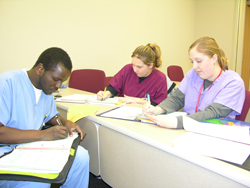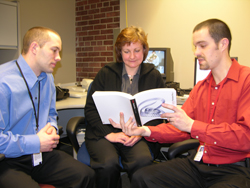 |
From left: clinical laboratory science students Farai Tsimab-Chitsva, Courtney Rosendahl and Kelli Chocholousek work on a case study in class. |
Today, thanks to distance education programs, students can earn some degrees without stepping foot on campus.
The revolution in online educational programs began at UNMC in 1990 when the Nebraska Legislature mandated that medical center programs be available in rural sites to address health professions shortages and access issues.
“Increasing the number of allied health professionals is very important in our rural communities,” said Kyle Meyer, associate dean of the School of Allied Health Professions. “Our distance education programs are a benefit to communities struggling to attract health professionals.”
UNMC has made many of its programs, including several from the School of Allied Health Professions, available via distance education.
An example of this was the school’s Clinical Laboratory Science (CLS) program, which under former program director, Phyllis Muellenberg, launched its first distance education program in 1990.
“There were a lot of qualified candidates, but the problem was most couldn’t afford to take a year off from their jobs, leave their families, and come to Omaha to get a bachelor’s or other degree,” said Maggie Winnicki, a distance education administrative coordinator in the School of Allied Health Professions.
At first, distance education included mailing videotapes for students to watch, toll-free telephone conferences, as well as broadcasting classes live via satellite, said Karen Honeycutt, an assistant professor in the clinical laboratory science program. Now computers and the Internet are the main avenues of distance education, she said.
The School of Allied Health Professions’ established its first bachelor’s degree program using distance education with affiliate site agreements in Grand Island, Hastings, Kearney, Scottsbluff, Lincoln and North Platte. The school provides program curriculum and faculty instruction. Affiliate-site faculty and coordinators provide one-on-one training and supervision in labs, said Linda Fell, program director of the CLS program.
Students begin the program at UNMC for 11-weeks in the summer and then return to their communities to work in labs and resume their degree program.
One of the major goals of distance education programs in smaller communities is retention in the communities after graduation, she said.
“We’ve been able to recruit students into our distance education programs who would have probably never completed the program otherwise,” she said. “Someone married with four children doesn’t come to Omaha for school but they will go to school near home.”
 |
Karen Honeycutt, center, talks with instructional technology specialists, Josh Nicholson, right, and Jeremy Boldt in the Faculty Development Center, a campus resource for converting media to instructional format for the Internet. Honeycutt is an assistant professor in the clinical laboratory science program. |
In 2004, the Career Advancement through Distance Education Technology (CADET) project was launched with grant funding, enabling the school to establish an online degree completion option in clinical laboratory science and in the radiation sciences. Shortly after, the clinical perfusion program launched a master’s degree completion option.
The new options allowed students to continue working in their communities while completing their degree exclusively online. To date, the school has enrolled 71 students, has 30 graduates and 550 prospective students pursuing prerequisites to apply to one of the programs in the near future.
Subsequent grants have added additional affiliate sites in CLS and radiography, with new affiliate agreements in Norfolk, Grand Island, Casper, Wyo., Sioux Falls, S.D., and Creighton University. UNMC is also helping the University of Missouri at Columbia with its distance learning programs.
The school has formed collaborations with local community colleges, including Central Community College in Grand Island and Columbus and is expanding agreements beyond a five-state area.
One factor that’s fueling demand for UNMC programs is that many allied health programs across the country are closing because of cost.
Though about 12,000 new allied health graduates with degrees are needed each year, only about 5,000 are currently graduating each year, Winnicki said.
The school continues to adapt curriculum for both online programs and its traditional programs.
“In many of our curricula, faculty have gradually applied distance methods to more and more of our course offerings,” Meyer said. “We receive positive feedback from students and their employers, as well as see continued high success rates of graduates on professional licensure and certification exams.
“In some cases, students enrolled in traditional programs have expressed greater satisfaction with the distance components because of scheduling flexibility and convenience of completing assignments in the morning or evening,” he said.
The impact of the medical center’s distance education has also been felt internationally, Winnicki said.
“UNMC has an impeccable reputation around the world. Several institutions want to partner with us. We’re providing health education worldwide using cutting edge technology in distance education. We have some of the best faculty in the world at UNMC and we should share them,” Winnicki said. “We currently have students located around the globe, including Canada, Iraq, Germany and Trinidad.”
The school, in partnership with the UNMC Center for Continuing Education, also offers online courses to allied health professionals wanting additional or refresher training. There’s a growing demand from professionals in the field and by employers to keep up with the changing profession, Winnicki said.
“Being able to offer continuing education to professionals working in the field is just one benefit of faculty and staff having done all this work to put programs online,” Winnicki said. “The online market is there. I think we’re going to find it will be extremely beneficial to develop more continuing education opportunities online.”